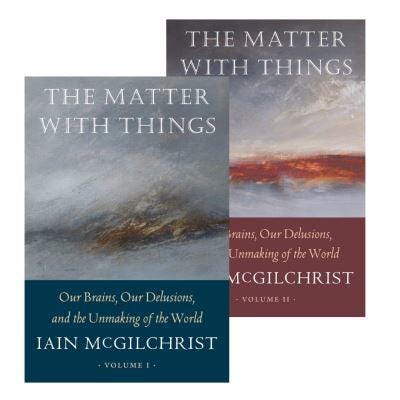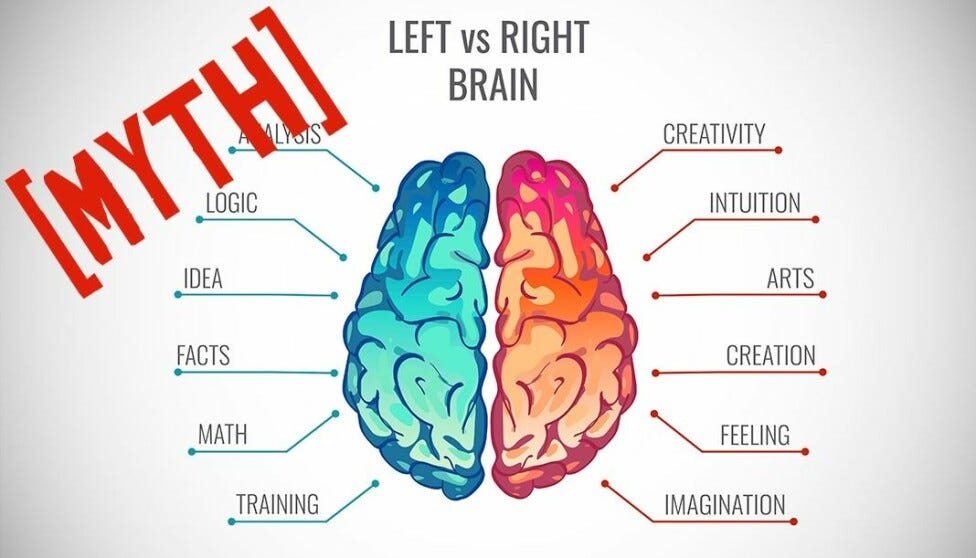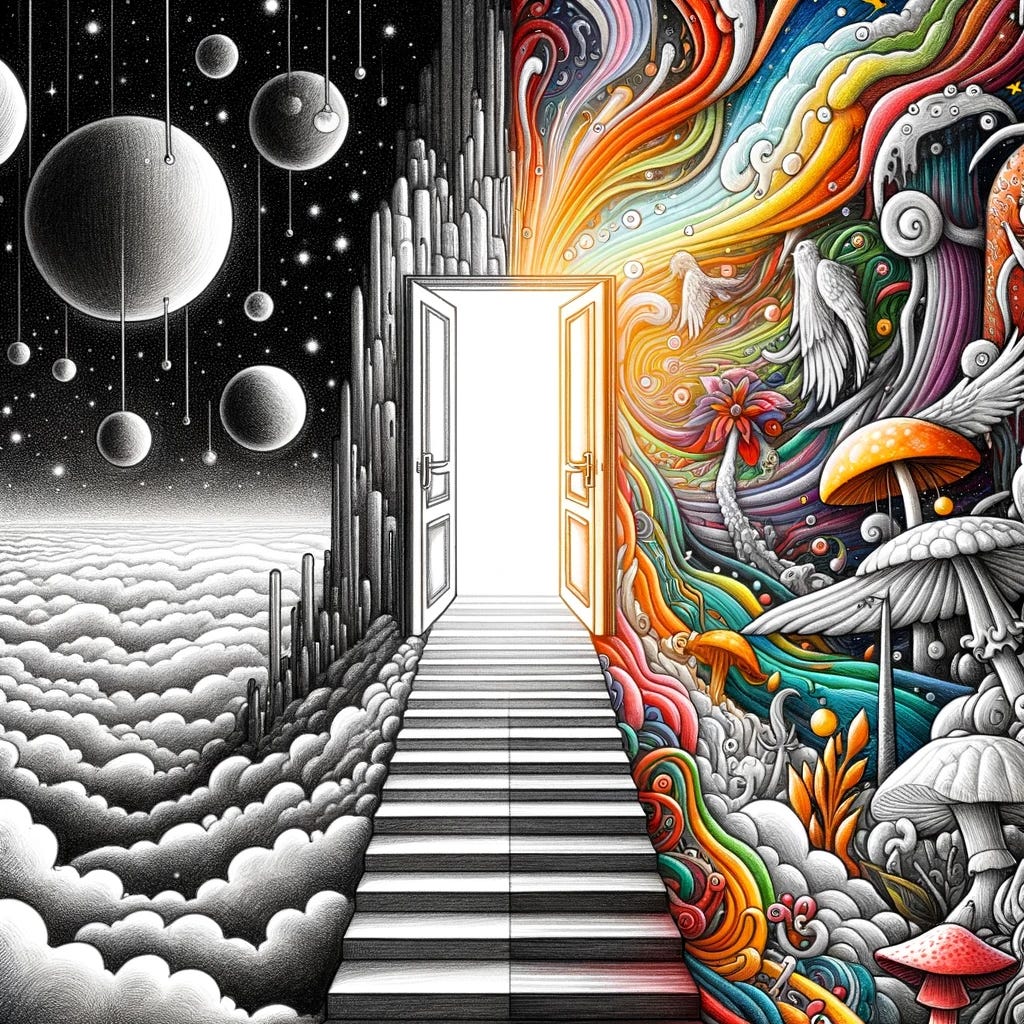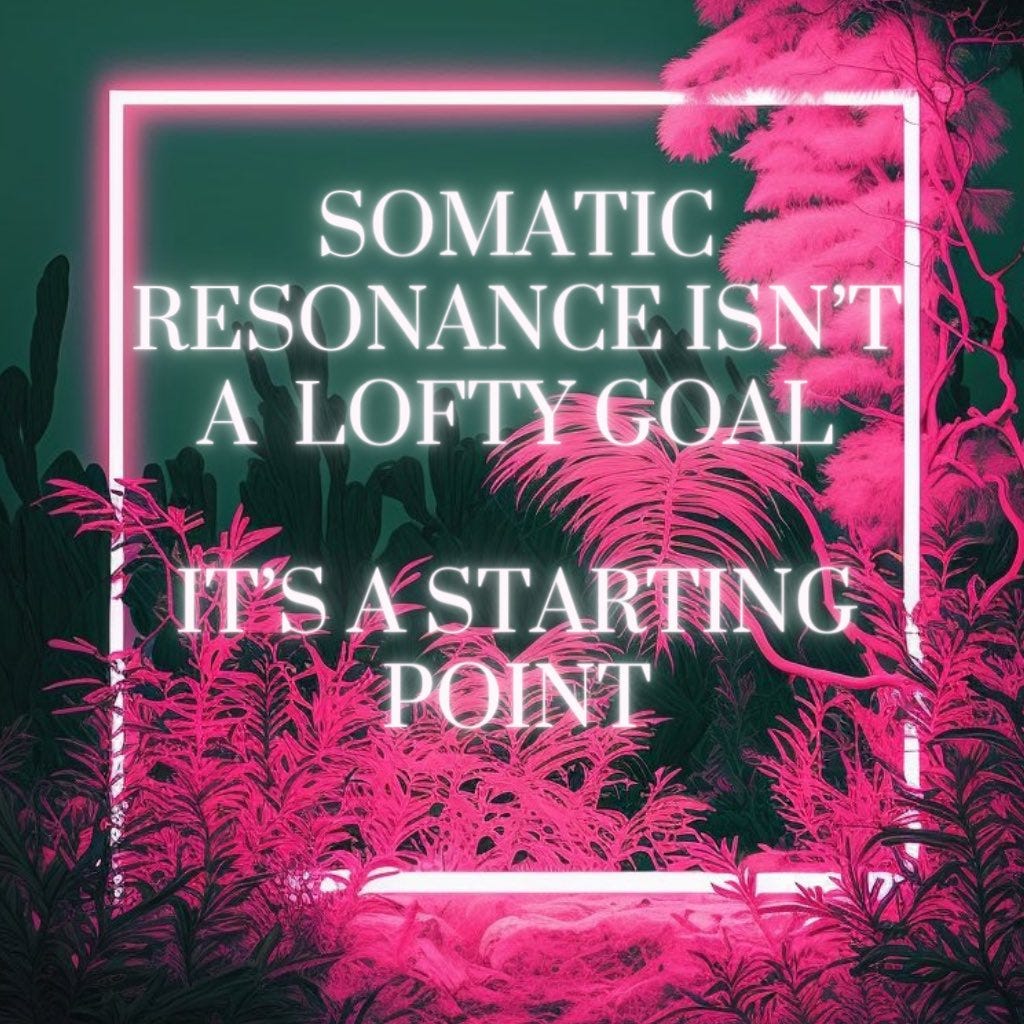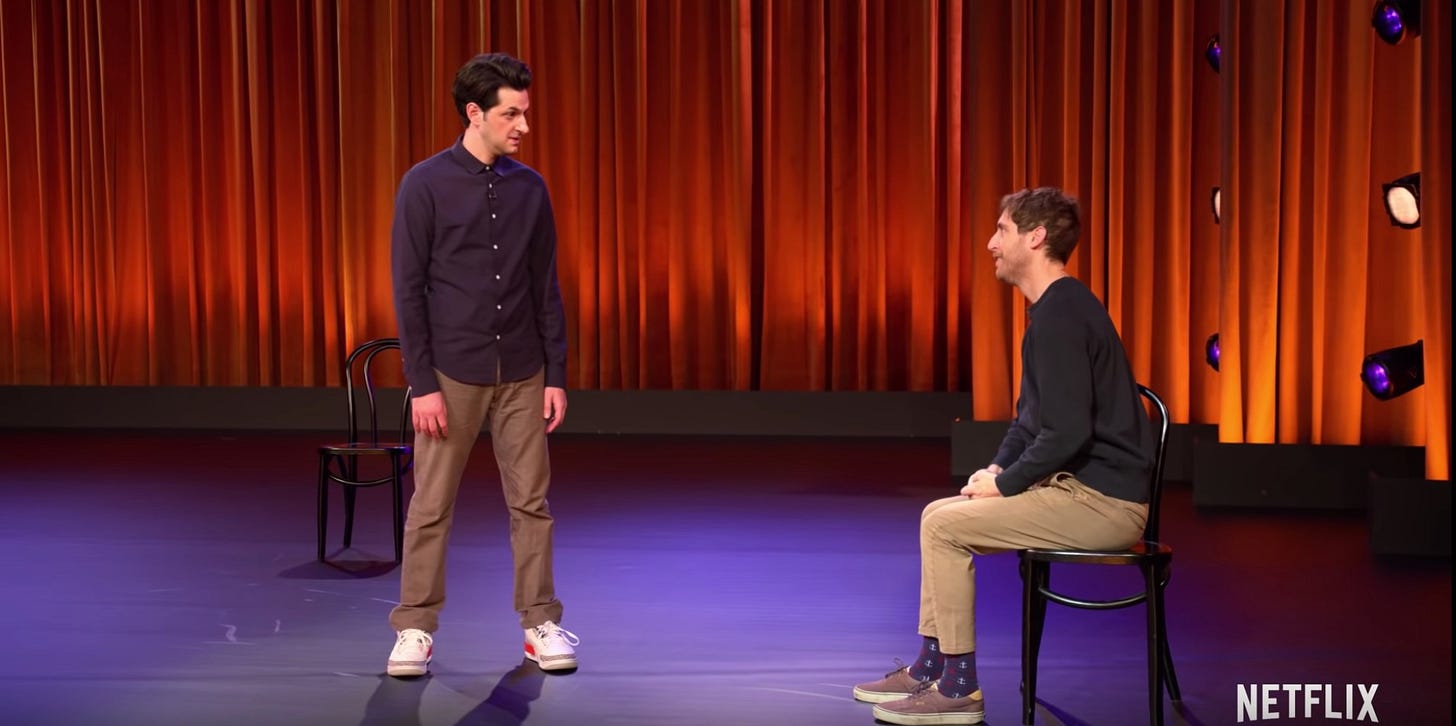Solving McGilchrist's Big Problem (or, fix right hemisphere imbalance with these 7 weird tricks?)
He never really gives ideas for WHAT TO DO about hemisphere dominance; luckily, I'm here for y'all
Iain McGilchrist’s place in the public consciousness is… weird.
He's theorized about how the right and left hemispheres of the brain — while both involved in everything we do — pay different kinds of attention to the world; his theories have drawn praise from the world's leading experts on brain lateralization (how the hemispheres work); his book The Master and His Emissary is a revered look at the ways those hemispheres have affected history and culture, and continue to do so today; his book The Matter with Things is the kind of 1500 page brick that makes reviewers use words like "magisterial" and makes readers say things like "I'll get around to it."
Overall, a pretty enviable situation. But his work isn't without detractors. Some of them are silly, but there are legitimate problems to point out. Because my hubris knows no bounds, I'm going to go ahead and solve one of those problems in this article, after a bit more preamble. (More like pre-ramble amirite?)
(The legit problem I'm focused on is "McGilchrist gives no practical steps. So what do I do?" -If you can relate to the question, maybe just skip the rest of my preamble and scroll down to "Practical Steps")
The silly criticisms are mostly flavored like "I heard that all the brain hemisphere stuff is a bunch of hooey, all this 'left-brained people like math, right-brained people like art' crap has been debunked, so knock it off." To which the main responses are:
Yes those theories were crap, and also they were never really theories. They were just pop magazine fluff that dumbed down early work on the hemispheres — and McGilchrist covers this quite a bit, writing on the ways legitimate work on hemispheric lateralization has been slowed down by misconceptions like those popular theories you're responding to.
McGilchrist's work may or may not be correct, but it pretty obviously can't be dismissed out of hand. I'm unqualified to assess the technical aspects, as are probably 95% of you reading this, but the people who are qualified (literally including a guy who won a Nobel Prize for his work in brain lateralization) say things like "I believe that at a deep level, McGilchrist is right" and "[this is] the best book on laterality I have ever read" and "He will be revered in future generations."
All of that doesn't mean he's right, but it does mean that the people who are best suited to examine his arguments find them compelling, plausible, and well-argued — which makes it weird to see random internet denizens confidently post "lol hemispheres differences are fake" in the comments.
Personally, the neuroanatomy of all this is only tangentially interesting to me. My main interest is the fact that the two modes of experience McGilchrist describes (one associated with the left hemisphere, the other with the right) match up pretty precisely with two modes of experience that have been described again and again elsewhere, from Taoism1 to John Keats' letters2 to Federico Campagna's philosophy3 to Proust — you can even see it in things like Finite & Infinite Games and the poetry of William Blake, if you're looking.
Over and over again, whenever people examine their own minds, the quality of their attention, the ways that they move through the world — they seem to notice these two broad "modes" that we can fall into.
One of these modes (matching McGilchrist's descriptions of the left hemisphere) has a narrow, direct focus. It wants to control and contain everything. It blocks out anything it doesn't think is important, which often includes emotions and whatever else can't be held, touched, measured. This mode lives in a fragmented world of many parts, many separate things that can be examined, taken apart, put back together — a world where nothing matters more than anything else, where any meaning that doesn't fit on a spreadsheet or succinctly into clear words is either imaginary or useless, and thus should be ignored. It tends to get stuck in its habitual ways of acting, interacting, and viewing things.
The other mode (matching the right hemisphere) has a broad, open awareness. It doesn't focus on one specific thing, but on gestalts, the whole situation, all of the interconnected parts forming a single image. Thus, this mode notices and processes even information that's hard to break down or quantify, like emotions, intuitions, embodied sensations, social cues, or a vague back-of-the-mind feeling that there's something important about an idea your friend just mentioned. It is capable of feeling awe and staying open to the unexpected, to the value of keeping an ear to the wind.
As you might guess, the thrust of McGilchrist's argument is that we moderns are stuck in left-hemisphere mode, and need to re-balance lest there be (more) dire consequences. The image of proper balance is the title of his most famous book: The Master and His Emissary. The right hemisphere should be the master, in charge of things, and the left hemisphere should be its emissary, a functionary that skillfully carries out the local tasks it's suited for.
His advice on how to do this is... kind of non-existent.
Really, I haven't been able to find much. Every time I talk with someone about McGilchrist, this point always comes up. "Everything about the two modes rings true, and I see a lot of useful implications in how he draws them out, but... I'd love to hear him talk about what we do now."
The omission is glaring enough that it seems intentional. At the very end of The Matter with Things, the final section of the Epilogue is titled "So What Should We Do?" In this section, he proceeds to give nearly zero practical steps. That's kinda funny, honestly. I have to respect it.
I could say a bit more about the theories me and my buddies have come up with for why McGilchrist has this issue, but I've already made this preamble much longer than I meant to. So instead, I'll just say that whatever qualms McGilchrist has about giving out practical steps people can take to move towards "re-balancing the left and right hemispheres," I don't share those qualms, and I've actually come across a lot of things that seem to work well. Let's look at a few.
Practical Steps for Re-Balancing Your Hemispheres
First off, I just want to say again that I'm not particularly interested in whether these steps literally change the engagement patterns of our left hemisphere (LH) and right hemisphere (RH). If that's how this works, great. But regardless of how it works, it's very clear that humans have two co-present "modes" of experience — I call them the Spontaneous and Systematic modes — and that we tend to get stuck in the systematic one, which causes a lot of problems like
emotional detachment.
relational detachment.
loss of a sense of meaning.
a feeling that you're watching your life in the 3rd person, rather than living it in the 1st person.
disembodiment, seeing "yourself" as being transported around "in" a body, rather than experiencing your body as an inextricable element of yourself.
obsession with "doing" and "trying" and "techniques" that let you systematize and control your experience.
loss of spontaneity, aliveness, awe, wonder.
a bunch of other stuff
So I'm less concerned with whether we could brain scan someone after doing the activities below and see a difference in right hemisphere engagement — I'm more concerned with whether someone who tries out some of these activities and clicks with a couple of them finds more liveliness, connection, meaning, and relaxed agency in their own life.
Let's kick off:
Spontaneous Mode
This is kind of the "sudden awakening" option, like in Buddhist stories when some lucky student skips all the training and practice and undoing and just snaps into liberation.
In our case, go back and read those descriptions of spontaneous "right hemisphere" engagement. Maybe go skim some other books, articles, or podcasts on the subject. Then sit down somewhere comfy, let your attention drift — and magnetize your awareness to open, spacious, spontaneous right-hemisphere space. Let yourself drop and expand into it.
Did that work? It's worth a shot, you never know.
Whether it worked for any of you or not, the thing is, once you can reliably find that "spontaneous space" in your experience, it doesn't matter much what you're doing — whether you're doing taxes or meditating or skipping through a field of daisies or picking up milk at the corner shop — you have the option of letting yourself do it in a more right-hemisphere-y way, of simply expanding into it.
Keep that in mind with the rest of these options below — these specific activities aren't special, except in how they make you more likely to drop and expand into this right hemisphere balance we're looking for. But once you have that move available, you can use it in anything you do.
Meditation (specific types though, to start)
When you're looking to cultivate a particular state of mind, meditation is the first port of call.
First things first: the LH way of being is marked by narrowed focus, a need for control, and a tendency to ignore everything it decides isn't relevant. This means that any meditation method that does these exact same things is going to be less than helpful for our goals.
So all these meditations where you narrow your focus to the breath and ignore everything else; where you try to count the breaths without distraction; where you pin your awareness to a single point; where you try to control your posture quite rigidly — those are all best left aside. Focus-based meditations can help us go beyond mere blinkered focus, but using them as a starting point is kind of like learning to ride a bike by running over a tricycle in your car. It just doesn’t quite connect, and tends to cause more problems than it solves.
In the case of cultivating more open, intuitive RH qualities, we're going to want to go with a type of meditation based on the qualities and strengths of that right hemisphere. McGilchrist brings up again and again that the right hemisphere is more deeply connected with the body than the left one, and that it specializes in broad, open awareness — so our obvious choices are open awareness meditation and somatic meditation.
The go-to options for learning about these are:
Basically any kind of meditation where the primary instruction is to deepen into the body (not just to scan the body as an object) or to expand into open awareness.
Aside from being a great starting point for exploring spontaneous RH-space, these types of meditation (as well as Metta) are also just the best starting points for a meditation practice in general.
Alexander Technique
The Alexander Technique is ostensibly a way of improving posture, but mostly it's about awareness. Namely, it's about expanding awareness — everything else is downstream from that.
Because the central trait of the RH is open, attentive awareness, a technique that's all about finding ways to keep your awareness open and attentive in everyday life seems pretty obviously desirable for our goals.
On top of that, so very many of the reviews and testimonials and accounts from people who spend serious time with this technique match up really well with the notion that AT will put you into RH-space. They commonly describe a sense of feeling unconstrained, of waking up to things you hadn't noticed before, of being free and open and alive to whatever's present. Basically, it seems to be one of the more reliable steps in the direction of everything McGilchrist wants to happen.
Somatic Resonance
I already shilled somatic meditation above, but I do want to specifically note that somatic resonance goes way beyond meditation. The core of somatic resonance is a way of approaching the body, whether you're meditating, dancing, walking, or skydiving — essentially, it's letting the body be aware of itself. Most people, day to day, feel like they exist inside their head, behind the eyes; like the body is some vehicle beneath them, carrying them around. McGilchrist notes:
Only the right hemisphere has a whole body image; the left hemisphere sees the body as an assemblage of parts, and as if it were an object in space alongside other objects, rather than a mode of existence. ...For the right hemisphere, we live the body; whereas for the left, we live in it, rather as we drive a car.
Embodiment practices in general are a helpful step in the direction of RH-space — but any embodiment practice that maintains a LH mode – that experiences the body as an assemblage of parts that you live in and "drive around" – isn't taking you very far.
Many body-scanning meditation methods do little or nothing to untangle and uncover that key point. They keep the managerial LH self in the head, letting it check in on the rest of the body, which stays out there. The RH-space only reveals itself when instead of "me" feeling "the body," I become the body that feels itself.
Intermezzo: Mêtis
At this point, it feels relevant to bring Peter Kingsley into the mix. He doesn't give any specific practices or activities, or even mention brain hemispheres, but his descriptions of the Greek concept of mêtis are a refreshing look at what hemispheric balance with RH dominance can look like.
Mêtis is the particular quality of intense alertness that can be effortlessly aware of everything at once. While our wandering minds go off on their endless journeys, it always stays at home. And its home is everywhere. Mêtis feels, listens, watches; can even be aware at the same time... of every thought drifting into and out of our consciousness. It misses nothing.
This description of alert, spacious awareness paints a picture of the hemispheres working powerfully together. Open awareness doesn't need to be drifty, foggy, unattached to anything as it floats around you — you can be open and aware, keeping an eye on everything in your context, while also being alert and sharp, ready to respond however you need to.
Mêtis is the one essential quality navigators need if they are going to keep a straight course instead of drifting, wandering, traveling aimlessly backwards and forwards, being led astray.
Elsewhere he describes mêtis as "presence and continuous alertness," a way of being "always aware of the whole without excluding anything." He compares this state favorably to a lesser state that looks more spectacular and is easier to acquire, but that "focuses on the immediate challenge to the exclusion of everything else," and thus is under-ripe and even harmful in many situations.
It's really hard to read that passage and not see the left and right hemispheres (or whatever else we call these two modes of experience) ghosting their way through the pages.
We'll come back to this point, but it's worth stating and remembering: it's easy to think we know what RH-dominance looks like – maybe like some sagely contemplative absorption – but seeing it in action is always surprising. It tends to be more lively and wily than we imagine insight and wisdom to be.
Drawing
There's an old book people have recommended me over and over again, Drawing on the Right Side of the Brain. I ignored the recommendation for too long, and I really shouldn't have. I haven't gotten through the whole thing yet, but the practice I've done so far does seem promising.
The basic premise is that most of us who think we're "bad at drawing" are actually just too caught up in symbolic LH approaches that blind us to reality. We look at something, but we don't actually see it — our left hemisphere reduces it to a few crude parts, which we then draw, and of course it looks terrible.
If we can find a way to get past the LH filter, and instead draw from RH-space, our drawing skill improves immeasurably, because we're drawing what we actually see instead of the crude, half-blind, reduced version the LH shows us.
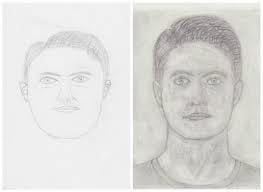
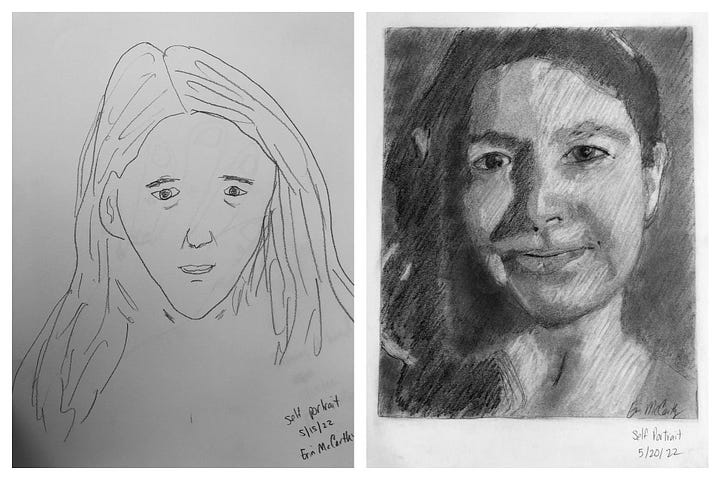
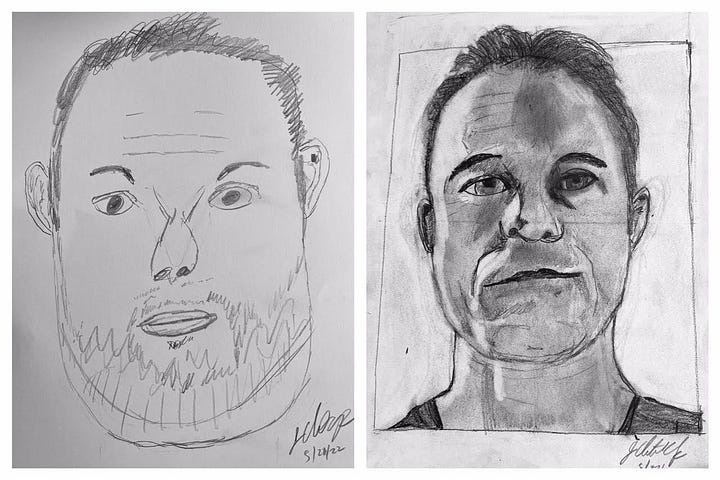
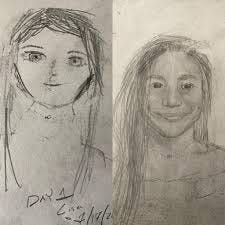
I've only done the first few exercises, and honestly I'm shocked how well it worked. I've produced a handful of the best drawings I've done in my life, just from reading the first 50 pages or so. They're still not like, good drawings; I need a lot of practice. But they're unquestionably leaps and bounds better than anything I've ever done before, with absolutely zero practice, just from following some basic advice about getting around the LH filter of habitual ways of seeing.
There's one general bit of advice I came across in her book that I want to share, because it's been useful to me and because it gives you an idea of how this whole RH thing works. The book suggested drawing in ways that frustrate your usual LH habits — for example, trying to draw something upside down from how it looks in front of you. The logic here is that if you give the LH a task that it doesn't want to do, it goes away and refuses to do it, leaving only the RH to pick up the slack. I have no idea how realistic this is on a neuroscience level, but on a practical level, that frame has been helping me a lot. I've been taking a lot of tasks and forcing myself to do them in difficult, silly, whimsical ways, and it does open the task up into broader RH-type awareness.
Additionally, drawing has the benefit (for our purposes) of being a type of art, which is our next subject.
The Artist's Way
Forgive me if we're starting to smack of the old pop-psych "RH loves art and music!" stuff — but those fluff pieces weren't making things up out of whole cloth. If you want to go real deep on it, Chapter 8 of McGilchrist's The Matter with Things examines the roles of the left and right hemispheres in creativity and problem-solving. This does seem to be an area where — although both hemispheres are involved in everything, obviously — the right hemisphere is pretty unquestionably dominant.
And leaving hemispheres aside, it's hard not to notice how the process of artistic creation puts us (if we spend significant time at it) into a delicious state of open spontaneous flow, a state where it feels less like we're controlling the situation to do something, and more like we're surrendering to a current of what wants to be done through us.
When aiming for this artistic RH flow, any kind of artistry will do (painting, poetry, composing...) and you don't need a program to get it done. But, in the interest of keeping this list on the level of practical, actionable steps you can take, I do want to say that The Artist's Way is a time-tested way of developing an artistic habit. Of special interest to us is the fact that The Artist's Way pretty specifically focuses on the cultivation of a lot of RH traits, rather than on artistic skill or achievement (which are downstream of this attitude of artistry).
A relevant bit from The Matter with Things:
Studies have been carried out more directly on healthy artists and composers. Artists exhibited 'strong right hemispheric dominance', which was much weaker in non-artists; and this was present not only when they were engaged in a creative task, but when they were directly perceiving or visualizing works of art — and indeed when at rest.
When you spend time developing artistic skill and practice, you develop increasing RH dominance, even at rest. Wild stuff.
Obviously, not all of us can just take up painting or composing full-time in a quest for hemispheric balance, but we are all capable of cultivating a creative artistic habit, of noticing the spacious current it drops us into when it's going well, and of bringing that mindset to more areas of our lives.
Improv
I know, I know, I know. We as a culture have agreed to groan at the very mention of improv. I wouldn't have even put it on this list (though I suspect it's pretty powerful) because I'd rather not end on a groan, but...
First off, I've lost track of how many people have recommended the book Impro to me. I still haven't read it, but everyone I know seems to love it, and the way they describe it, it feels pretty clearly familiar to me from my experience with some of the items above. It sounds like a pretty powerful inroad to RH-space — or actually into a near-ideal hemispheric balance — and it's not difficult to guess why. It requires open, attentive awareness not just to the space around you, but to the people around you, and to the situation you've all been imagining together for the past few minutes. It requires you to be spontaneous, to bypass the part of you that overthinks things, to be creative, artistic, and intuitive — and to use your body in the same spontaneous intuitive way. It hits pretty much all the RH hallmarks.
But still, I wasn't going to put it in this article — until last night, after writing the first draft, I pulled up Netflix and watched Middleditch & Schwarz. It's a series of three long-form improvised comedy specials by Ben Schwarz and Thomas Middleditch, and it is hilarious. Absolutely killed me.
But more than being hilarious, what stood out to me was what a delightful and lovely example of RH-space it was, and an example I think bucks against a lot of the preconceived notions people have about how this state looks. For a lot of people, I think talking about "open, intuitive, embodied awareness, in spontaneous flow etc etc" gives an image of some kind of sagely white-haired figure on a mountain top, existing at the center of all things with a soft voice and half-closed eyes.
The improv show busts up that image, reminding me more of the vision of the sage we see in Taoist writers like Chuang Tzu — a lively, tricky fellow, spry and witty.
At a lot of points, the show struck me as an example of mêtis, that “particular quality of intense alertness that can be effortlessly aware of everything at once.”
They clearly were holding a huge amount in their awareness. In the space on the empty stage, they both exhibited a lot of awareness of what physical environment they had already established bit by bit over the course of the show. And also in time, they remembered, called back to, and built on what the two of them had said and done earlier in the show, while each playing multiple characters. At one point, Middleditch, standing at the corner of the stage, started moving his hands as if making a drink, reminding me that 20 minutes earlier another character had poured himself a whiskey in that exact spot.
And all of this is done while keeping a consistent story going, bouncing back and forth between playing multiple characters, reading the audience and keeping the pace of jokes and plot development going, and being aware of how much time they had left to move the story along and wrap things up.
If we're looking for ways to cultivate mêtis, to re-balance our own habits towards the right hemisphere's spontaneous mode of experience — which, McGilchrist both implies and outright states that we as a culture need to be doing just that — it would be a mistake to leave out possibilities like improv and acting. It seems clear to me that they build the relevant habits, at least as much as things like somatic meditation, art, or the Alexander Technique. (It goes without saying that combining multiple of these does more than picking just one.)
Conclusion
There you go. It's by no means an exhaustive list, but those are some of the places I see the most potential to build up a more spontaneous mode of experience, and bend yourself a little more towards right hemisphere dominance.
And just to repeat what is maybe THE critical point in all this: there's nothing special about these activities, except that they're some of the more reliable places to start cultivating this kind of access. Once you find and deepen your access to spontaneous mode, to RH-space, to magic, whatever we call it, it's much easier to allow it into other areas of your life. Activities like these are nothing more than an entryway — once you're through the front gate, you can work on unlocking more of the rooms pretty easily. So there's no need to get stuck on making improv or drawing or meditation the center of your life, the only thing you care about as you get addicted to the feeling of open spontaneous awareness — you can infuse every part of your life with that mode of experience, until shopping for milk casts the same sparky glow as a morning meditation.
End Note: it wouldn't be that much of an oversimplification to say that a big part of my own work is helping people find this shift from LH to RH — from Systematic to Spontaneous mode. It's why I made the somatic resonance course, it's a key part of my focus on Imaginal Literacy, and it's at the core of my Deep Aliveness cohorts. If you get started with anything and have questions about this kind of shift, feel free to get in touch.


